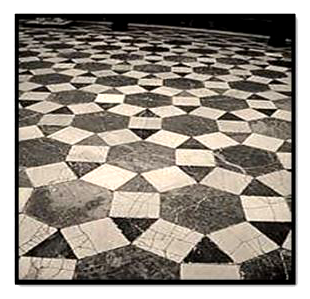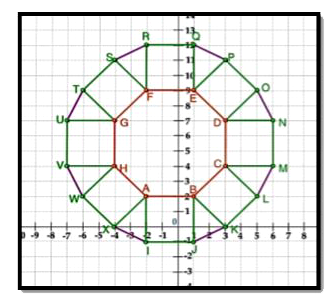A tiling or tessellation of a flat surface is the covering of a plane using one or more geometric shapes, called tiles, with no overlaps and no gaps. Historically, tessellations were used in ancient Rome and in Islamic art. You may find tessellation patterns on floors, walls, paintings etc. Shown below is a tiled floor in the archaeological Museum of Seville, made using squares, triangles and hexagons.

A craftsman thought of making a floor pattern after being inspired by the above design. To ensure accuracy in his work, he made the pattern on the Cartesian plane. He used regular octagons, squares and triangles for his floor tessellation pattern

Use the above figure to answer the questions that follow:
(i) What is the length of the line segment joining points B and F?
(ii) The centre ‘Z’of the figure will be the point of intersection of the diagonals of quadrilateral WXOP. Then what are the coordinates of Z?
(iii) What are the coordinates of the point on y axis equidistant from A and G?
Step by step video & image solution for A tiling or tessellation of a flat surface is the covering of a plane using one or more geometric shapes, called tiles, with no overlaps and no gaps. Historically, tessellations were used in ancient Rome and in Islamic art. You may find tessellation patterns on floors, walls, paintings etc. Shown below is a tiled floor in the archaeological Museum of Seville, made using squares, triangles and hexagons. A craftsman thought of making a floor pattern after being inspired by the above design. To ensure accuracy in his work, he made the pattern on the Cartesian plane. He used regular octagons, squares and triangles for his floor tessellation pattern Use the above figure to answer the questions that follow: (i) What is the length of the line segment joining points B and F? (ii) The centre ‘Z’of the figure will be the point of intersection of the diagonals of quadrilateral WXOP. Then what are the coordinates of Z? (iii) What are the coordinates of the point on y axis equidistant from A and G? by Maths experts to help you in doubts & scoring excellent marks in Class 10 exams.
Topper's Solved these Questions
Similar Questions
Knowledge Check
- Question 1 - Select One
Polymer used in marking floor tiles is
AteflonBpolypropyleneCpolyvinyl ChlorideDbuta-1, 3-diene - Question 2 - Select One
Tesselated epithelium can be traced in :
ABlood vesselsBMesotheliumCPeritoneumDAll of these - Question 3 - Select One
The length and breadth of a room are 13 m and 7 .5 m, respectively. The floor of the room is to be paved with square tiles of uniform size. Determine the length of the largest possible size of the tile.
A1.0 mB0.5 mC1.5 mD5.0 m
A rectangular courtyard is 3m 78 cm long and 5m 25 cm broad. It is desired to prove it with square tiles of the same size. What is the largest size of the tile that can be used ? Also find the number of such tiles.
View SolutionAubrey wants to buy tiles for the floor of her drawing room. The dimensions of the floor of her drawing room are shown in the figure.

The perimeter of the floor isView SolutionSandra wants to get her kitchen floor tiled with square tiles such that each tile has a side of 2 ft. The kitchen is of 18 ft length and 16 ft width and each square tile has an area of 4 ft2. What is the area of the kitchen floor?
View SolutionWhat is tesselated epithelium ? Where is it found?
View SolutionThe length and breadth of a room are 13 m and 7 .5 m, respectively. The floor of the room is to be paved with square tiles of uniform size. Determine the length of the largest possible size of the tile.
View Solution


